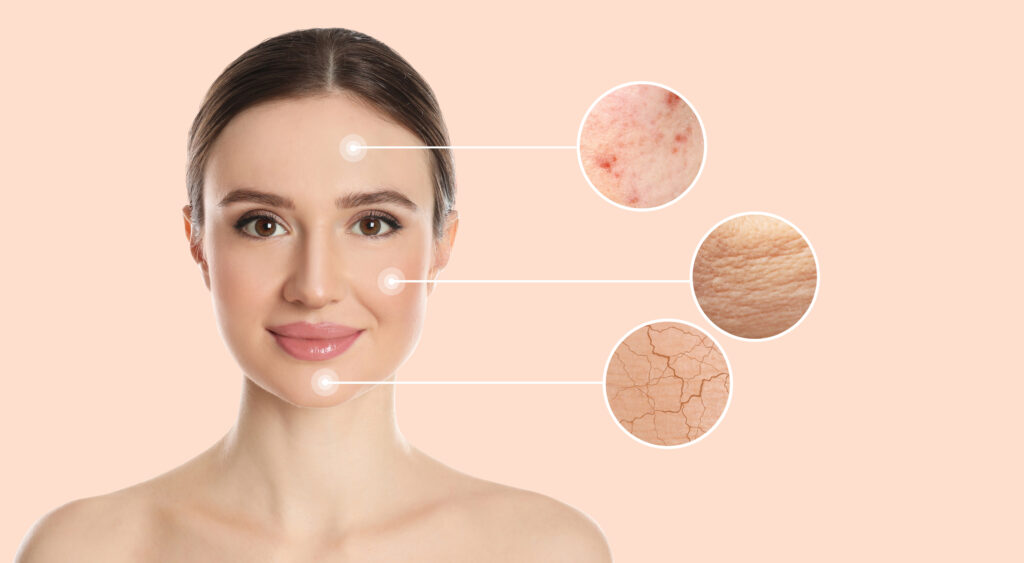
Whether you’re an aspiring aesthetician or a DIY self-care enthusiast, one of the fundamental skills of providing effective skin care is determining different skin types. For aestheticians, knowing your clients’ skin types is crucial for tailoring treatments and recommending appropriate products, and for everyone else, it’s important to understand your own skin’s unique characteristics so you can take the best possible care of it.
Keep reading to learn more about the basic skin types, how to determine which category you fit into, and get tips for determining the right treatments.
The Importance of Knowing Skin Types
Skin type identification is the cornerstone of effective skincare. Each type responds differently to various treatments and products, and using the wrong ones can have adverse effects. By learning how to accurately identify skin types, you can avoid potential issues like irritation and excessive dryness or oiliness, ensuring your and your client’s skin remains healthy and radiant.
The Five Basic Skin Types
There are five basic skin types — normal, oily, dry, combination, and sensitive — each with distinct characteristics and specific care requirements.
Normal Skin
Characteristics include balanced moisture and sebum production, small pores, smooth texture, and even tone. Individuals with normal skin rarely experience blemishes or extreme sensitivity. To care for normal skin and avoid disrupting its ideal balance, use light moisturizers, broad-spectrum sunscreens, and gentle cleansers.
Oily Skin
Oily skin is characterized by enlarged pores, excessive sebum production, a shiny complexion, and a tendency to develop acne and blackheads. Individuals with oily skin should opt for oil-free, non-comedogenic products, use salicylic acid or benzoyl peroxide treatments for acne, and include astringents or toners in their skincare routines.
Dry Skin
Dry skin lacks natural oils, causing it to feel tight and rough. It can also be more prone to fine lines and flaking. The goal is to repair the skin barrier with emollient products. Avoid harsh exfoliants, use hydrating cleansers and rich moisturizers, and incorporate products that include glycerin and hyaluronic acid.
Combination Skin
Combination skin has both oily and dry areas, typically with an oily T-zone (chin, nose, and forehead) and dry cheeks. Create a balanced skincare routine by using different products tailored to each zone, like rich creams for dry patches and lightweight moisturizers for the T-zone.

Sensitive Skin
As the name suggests, sensitive skin is easily irritated, often reacts negatively to certain products or environmental factors, and is prone to itching, burning, and redness. To prevent adverse reactions and protect the skin from damage, use fragrance-free, hypoallergenic products, incorporate soothing ingredients like chamomile and aloe vera, and avoid harsh chemicals and exfoliants.
Steps to Determine Skin Type
To determine a client’s skin type, incorporate these steps into their consultation. You can also perform these steps on yourself at home.
#1. Visual and Tactile Examination
Begin by looking at the client’s skin under sufficient light. Make note of any visible characteristics such as redness, oiliness, or flaky patches. Gently feel the skin to assess its moisture level and texture. Is it soft and smooth or rough and bumpy? Does it feel dry or oily?
#2. Cleansing Test
Next, have the client wash their face with a gentle cleanser and pat the skin dry. After a while, observe how their skin behaves without any products to gain insight into their natural skin type.
Normal skin remains comfortable without feeling tight or oily. Dry skin may feel tight and show signs of flaking, while oily skin can develop a noticeable shine. In combination skin, the T-zone becomes oily, while the cheeks remain dry. Sensitive skin may redden or show signs of irritation.
#3. Blotting Sheet Test
Use blotting papers to gently press on different areas of the face, identifying oily versus dry zones. Minimal oil on the blotting paper indicates normal skin, significant oil is a sign of oily skin, and little to no oil means dry skin. This test may not be as effective for identifying sensitive skin.

#4. Client Questionnaire
Ask your client about their skincare routine, which products they use, and whether they’ve experienced any skin issues. Include the following questions:
- How does your skin usually feel at the end of the day?
- Do you experience frequent redness or breakouts?
- How does your skin typically react to new products?
- Have you noticed any seasonal changes in your skin?
The Skin Institute: Building Fundamental Skills
At the Skin Institute, we recognize the importance of fundamental knowledge. We work with our students to build foundational skills, such as identifying clients’ skin types, that will help them find success as estheticians or aestheticians. Contact us today to learn more about how our basic and master esthetics courses can be the starting point for your future career!
